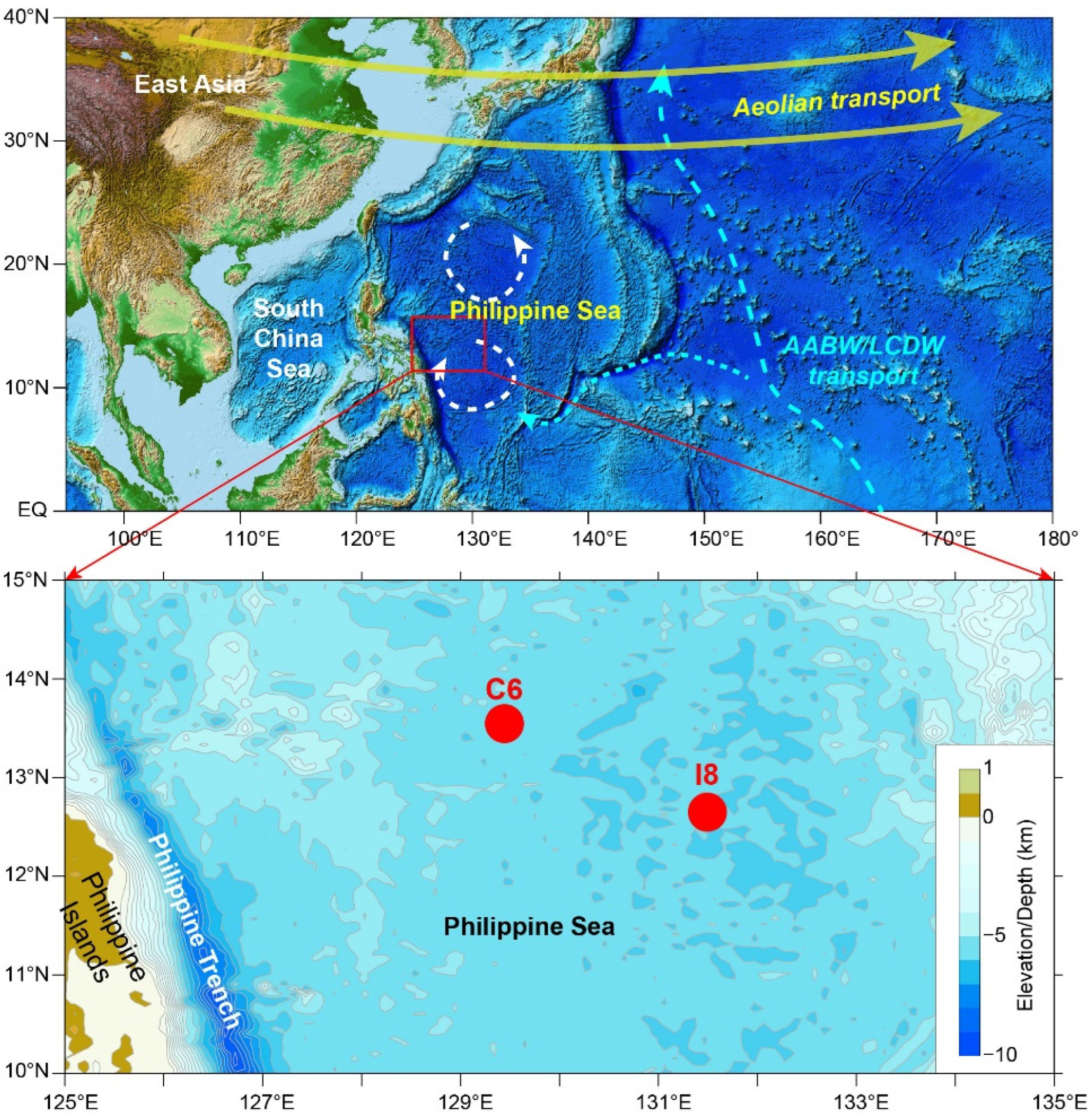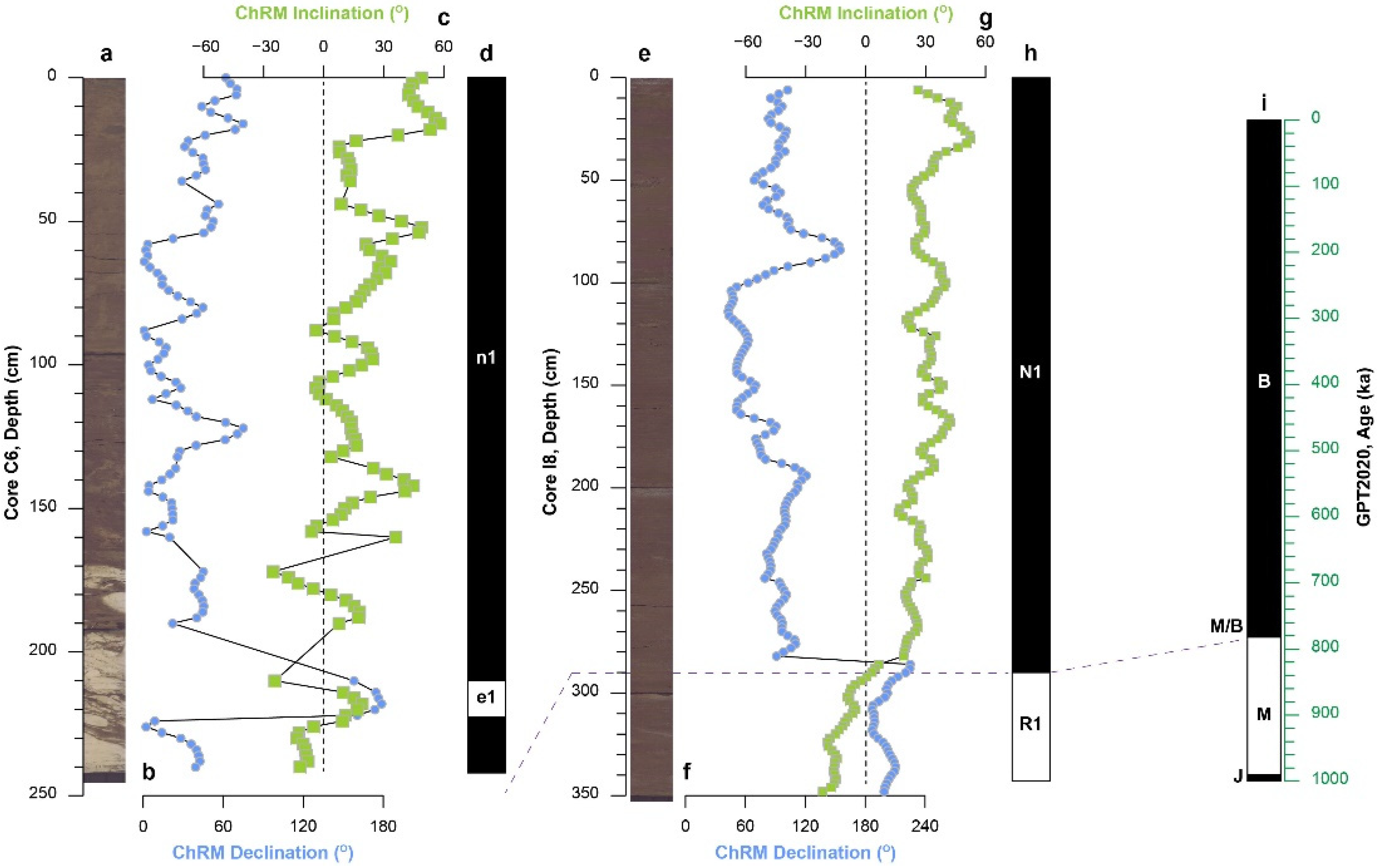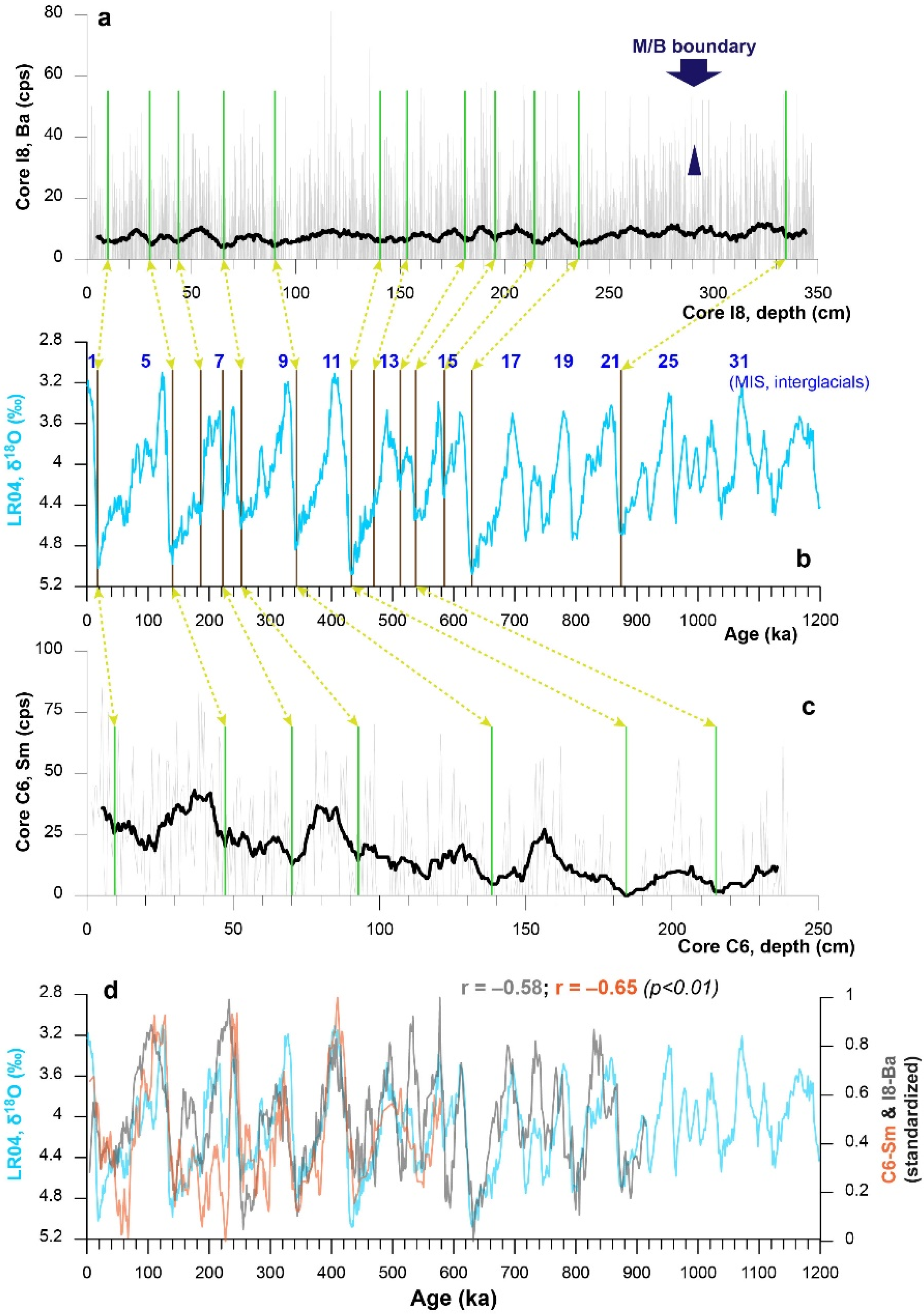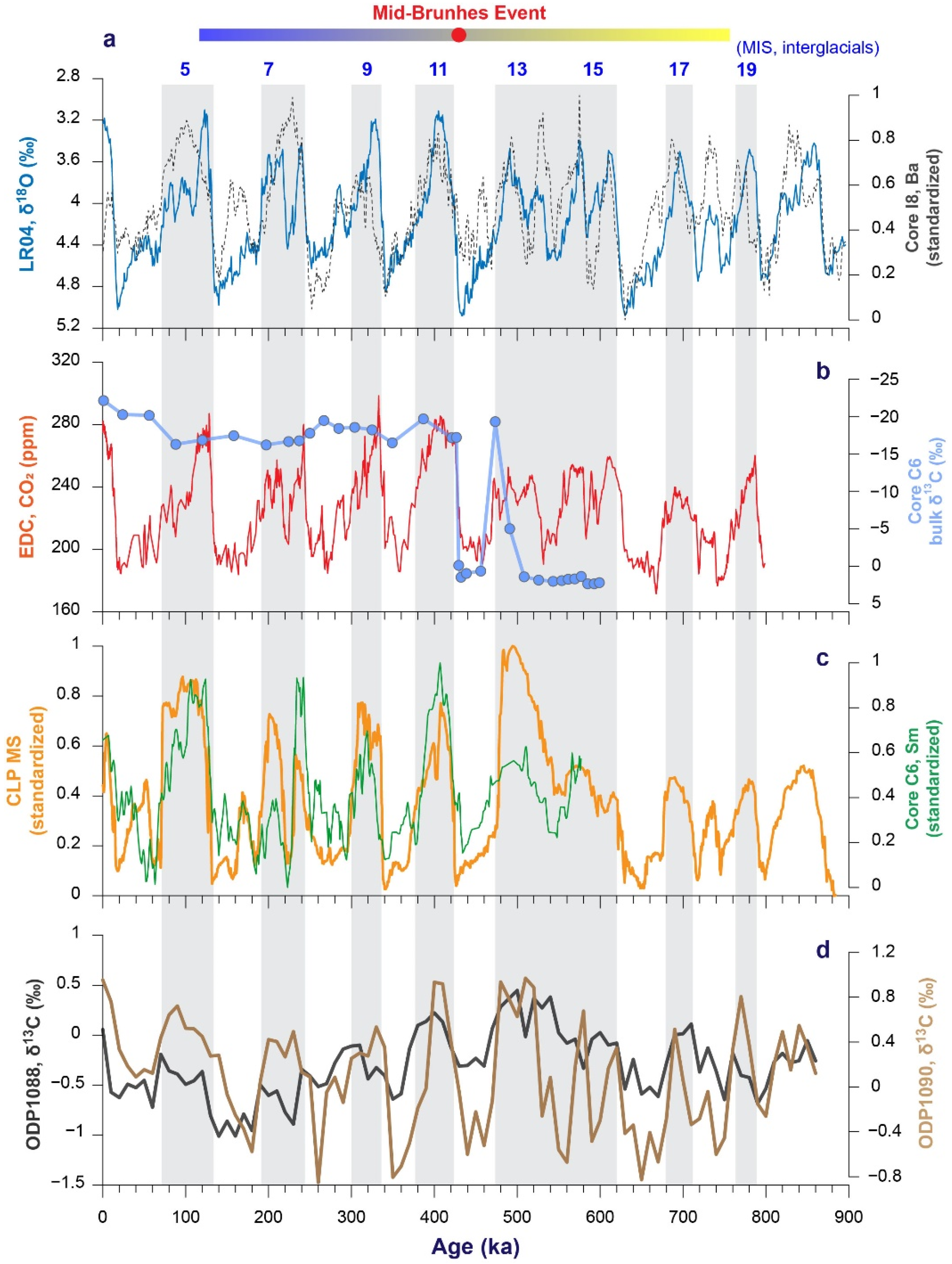Geochronological Evidence Inferring Carbonate Compensation Depth Shoaling in the Philippine Sea after the Mid-Brunhes Event
Abstract
:1. Introduction
2. Materials and Methods
2.1. The Studied Cores
2.2. Magnetic Measurements
2.3. Chemical Scanning
2.4. Bulk Sediment’s δ13C
3. Results and Analyses
3.1. Magnetostratigraphy
3.2. Tuning Element Contents
3.3. Carbonate Changes
4. Discussion
5. Conclusions
Author Contributions
Funding
Institutional Review Board Statement
Informed Consent Statement
Data Availability Statement
Acknowledgments
Conflicts of Interest
References
- Clark, P.U.; Alley, R.B.; Pollard, D. Northern Hemisphere Ice-Sheet Influences on Global Climate Change. Science 1999, 286, 1104–1111. [Google Scholar] [CrossRef]
- Lisiecki, L.E.; Raymo, M.E. A Pliocene-Pleistocene stack of 57 globally distributed benthic d18O records. Paleoceanography 2005, 20, PA1003. [Google Scholar] [CrossRef] [Green Version]
- Zachos, J.; Pagani, M.; Sloan, L.; Thomas, E.; Billups, K. Trends, Rhythms, and Aberrations in Global Climate 65 Ma to Present. Science 2001, 292, 686–693. [Google Scholar] [CrossRef]
- Jansen, J.H.F.; Kuijpers, A.; Troelstra, S.R. A Mid-Brunhes Climatic Event: Long-Term Changes in Global Atmosphere and Ocean Circulation. Science 1986, 232, 619–622. [Google Scholar] [CrossRef]
- Jouzel, J.; Massondelmotte, V.; Cattani, O.; Dreyfus, G.; Falourd, S.; Hoffmann, G.; Minster, B.; Nouet, J.; Barnola, J.M.; Chappellaz, J. Orbital and Millennial Antarctic Climate Variability over the Past 800,000 Years. Science 2007, 317, 793–796. [Google Scholar] [CrossRef] [Green Version]
- Lüthi, D.; Le Floch, M.; Bereiter, B.; Blunier, T.; Barnola, J.-M.; Siegenthaler, U.; Raynaud, D.; Jouzel, J.; Fischer, H.; Kawamura, K.; et al. High-resolution carbon dioxide concentration record 650,000–800,000 years before present. Nature 2008, 453, 379–382. [Google Scholar] [CrossRef]
- Loulergue, L.; Schilt, A.; Spahni, R.; Massondelmotte, V.; Blunier, T.; Lemieux, B.; Barnola, J.M.; Raynaud, D.; Stocker, T.F.; Chappellaz, J. Orbital and millennial-scale features of atmospheric CH4 over the past 800,000 years. Nature 2008, 453, 383–386. [Google Scholar] [CrossRef] [Green Version]
- Cheng, H.; Edwards, R.L.; Sinha, A.; Spötl, C.; Yi, L.; Chen, S.; Kelly, M.; Kathayat, G.; Wang, X.; Li, X.; et al. The Asian monsoon over the past 640,000 years and ice age terminations. Nature 2016, 534, 640–646. [Google Scholar] [CrossRef]
- Sun, Y.; Clemens, S.C.; An, Z.; Yu, Z. Astronomical timescale and palaeoclimatic implication of stacked 3.6-Myr monsoon records from the Chinese Loess Plateau. Quat. Sci. Rev. 2006, 25, 33–48. [Google Scholar] [CrossRef]
- Kemp, A.E.S.; Grigorov, I.; Pearce, R.B.; Naveira Garabato, A.C. Migration of the Antarctic Polar Front through the mid-Pleistocene transition: Evidence and climatic implications. Quat. Sci. Rev. 2010, 29, 1993–2009. [Google Scholar] [CrossRef] [Green Version]
- Yin, Q. Insolation-induced mid-Brunhes transition in Southern Ocean ventilation and deep-ocean temperature. Nature 2013, 494, 222–225. [Google Scholar] [CrossRef] [PubMed]
- Past Interglacials Working Group of Pages. Interglacials of the last 800,000 years. Rev. Geophys. 2016, 54, 162–219. [Google Scholar] [CrossRef] [Green Version]
- Barth, A.M.; Clark, P.U.; Bill, N.S.; He, F.; Pisias, N.G. Climate evolution across the Mid-Brunhes Transition. Clim. Past 2018, 14, 2071–2087. [Google Scholar] [CrossRef] [Green Version]
- Brook, E.J.; Buizert, C. Antarctic and global climate history viewed from ice cores. Nature 2018, 558, 200–208. [Google Scholar] [CrossRef]
- Woosley, R.J. Carbonate Compensation Depth. In Encyclopedia of Geochemistry: A Comprehensive Reference Source on the Chemistry of the Earth; White, W.M., Ed.; Springer International Publishing: Cham, Switzerland, 2018; pp. 204–205. [Google Scholar]
- Pälike, H.; Lyle, M.W.; Nishi, H.; Raffi, I.; Ridgwell, A.; Gamage, K.; Klaus, A.; Acton, G.; Anderson, L.; Backman, J.; et al. A Cenozoic record of the equatorial Pacific carbonate compensation depth. Nature 2012, 488, 609. [Google Scholar] [CrossRef]
- Lyle, M. Neogene carbonate burial in the Pacific Ocean. Paleoceanography 2003, 18, 1059. [Google Scholar] [CrossRef]
- Greene, S.E.; Ridgwell, A.; Kirtland Turner, S.; Schmidt, D.N.; Pälike, H.; Thomas, E.; Greene, L.K.; Hoogakker, B.A.A. Early Cenozoic Decoupling of Climate and Carbonate Compensation Depth Trends. Paleoceanogr. Paleoclimatol. 2019, PA003601. [Google Scholar] [CrossRef] [Green Version]
- Coxall, H.K.; Wilson, P.A.; Pälike, H.; Lear, C.H.; Backman, J. Rapid stepwise onset of Antarctic glaciation and deeper calcite compensation in the Pacific Ocean. Nature 2005, 433, 53–57. [Google Scholar] [CrossRef]
- Merico, A.; Tyrrell, T.; Wilson, P.A. Eocene/Oligocene ocean de-acidification linked to Antarctic glaciation by sea-level fall. Nature 2008, 452, 979–982. [Google Scholar] [CrossRef]
- Kawabe, M.; Fujio, S. Pacific ocean circulation based on observation. J. Oceanogr. 2010, 66, 389–403. [Google Scholar] [CrossRef]
- Zhai, F.; Gu, Y. Abyssal Circulation in the Philippine Sea. J. Ocean Univ. China 2020, 19, 249–262. [Google Scholar] [CrossRef]
- Kirschvink, J.L. The least-squares line and plane and the analysis of palaeomagnetic data. Geophys. J. R. Astron. Soc. 1980, 62, 699–718. [Google Scholar] [CrossRef]
- Lurcock, P.C.; Wilson, G.S. PuffinPlot: A versatile, user-friendly program for paleomagnetic analysis. Geochem. Geophys. Geosyst. 2012, 13, Q06Z45. [Google Scholar] [CrossRef] [Green Version]
- Calvert, S.E.; Pedersen, T.F. Chapter Fourteen Elemental Proxies for Palaeoclimatic and Palaeoceanographic Variability in Marine Sediments: Interpretation and Application. In Developments in Marine Geology; Hillaire–Marcel, C., De Vernal, A., Eds.; Elsevier: Amsterdam, The Netherlands, 2007; Volume 1, pp. 567–644. [Google Scholar]
- Haug, G.H.; Hughen, K.A.; Sigman, D.M.; Peterson, L.C.; Röhl, U. Southward Migration of the Intertropical Convergence Zone Through the Holocene. Science 2001, 293, 1304–1308. [Google Scholar] [CrossRef] [PubMed]
- Yao, Z.; Liu, Y.; Shi, X.; Suk, B.-C. Paleoenvironmental changes in the East/Japan Sea during the last 48 ka: Indications from high-resolution X-ray fluorescence core scanning. J. Quat. Sci. 2012, 27, 932–940. [Google Scholar] [CrossRef]
- Croudace, I.W.; Rothwell, R.G. Micro-XRF Studies of Sediment Cores: Applications of a Non-Destructive Tool for the Environmental Sciences; Springer: Dordrecht, The Netherlands, 2015; Volume 17, p. 668. [Google Scholar]
- Yi, L.; Xu, D.; Jiang, X.; Ma, X.; Ge, Q.; Deng, X.; Wang, H.; Deng, C. Magnetostratigraphy and Authigenic 10Be/9Be Dating of Plio-Pleistocene Abyssal Surficial Sediments on the Southern Slope of Mariana Trench and Sedimentary Processes During the Mid-Pleistocene Transition. J. Geophys. Res. Ocean. 2020, 125, e2020JC016250. [Google Scholar] [CrossRef]
- Yi, L.; Hu, B.; Zhao, J.; Jiang, X.; Shu, Y.; Wang, X.; Guo, J.; Wang, F.; Ding, X.; Liu, G.; et al. Magnetostratigraphy of Abyssal Deposits in the Central Philippine Sea and Regional Sedimentary Dynamics During the Quaternary. Paleoceanogr. Paleoclimatol. 2022, 37, e2021PA004365. [Google Scholar] [CrossRef]
- Gibbard, P.L.; Head, M.J. Chapter 30—The Quaternary Period. In Geologic Time Scale 2020; Gradstein, F.M., Ogg, J.G., Schmitz, M.D., Ogg, G.M., Eds.; Elsevier: Amsterdam, The Netherlands, 2020; pp. 1217–1255. [Google Scholar]
- He, F.; Wei, Y.; Maffei, S.; Livermore, P.W.; Davies, C.J.; Mound, J.; Xu, K.; Cai, S.; Zhu, R. Equatorial auroral records reveal dynamics of the paleo-West Pacific geomagnetic anomaly. Proc. Natl. Acad. Sci. USA 2021, 118, e2026080118. [Google Scholar] [CrossRef]
- Yi, L.; Wang, H.; Deng, X.; Yuan, H.; Xu, D.; Yao, H. Geochronology and Geochemical Properties of Mid-Pleistocene Sediments on the Caiwei Guyot in the Northwest Pacific Imply a Surface-to-Deep Linkage. J. Mar. Sci. Eng. 2021, 9, 253. [Google Scholar] [CrossRef]
- Jakob, K.A.; Pross, J.; Scholz, C.; Fiebig, J.; Friedrich, O. Thermocline state change in the eastern equatorial Pacific during the late Pliocene/early Pleistocene intensification of Northern Hemisphere glaciation. Clim. Past 2018, 14, 1079–1095. [Google Scholar] [CrossRef] [Green Version]
- Farrell, J.W.; Prell, W.L. Climatic change and CaCO3 preservation: An 800,000 year bathymetric Reconstruction from the central equatorial Pacific Ocean. Paleoceanography 1989, 4, 447–466. [Google Scholar] [CrossRef]
- Bickert, T.; Henrich, R. Chapter 12—Climate Records of Deep-Sea Sediments: Towards the Cenozoic Ice House. In Developments in Sedimentology; HüNeke, H., Mulder, T., Eds.; Elsevier: Amsterdam, The Netherlands, 2011; Volume 63, pp. 793–823. [Google Scholar]
- Murray, R.W.; Leinen, M. Chemical transport to the seafloor of the equatorial Pacific Ocean across a latitudinal transect at 135°W: Tracking sedimentary major, trace, and rare earth element fluxes at the Equator and the Intertropical Convergence Zone. Geochim. Cosmochim. Acta 1993, 57, 4141–4163. [Google Scholar] [CrossRef]
- Qin, B.; Li, T.; Xiong, Z.; Algeo, T.J.; Jia, Q. Deep-Water Carbonate Ion Concentrations in the Western Tropical Pacific Since the Mid-Pleistocene: A Major Perturbation During the Mid-Brunhes. J. Geophys. Res. Ocean. 2018, 123, 6876–6892. [Google Scholar] [CrossRef]
- Anderson, R.F.; Fleisher, M.Q.; Lao, Y.; Winckler, G. Modern CaCO3 preservation in equatorial Pacific sediments in the context of late-Pleistocene glacial cycles. Mar. Chem. 2008, 111, 30–46. [Google Scholar] [CrossRef]
- Xu, Z.; Li, T.; Clift, P.D.; Lim, D.; Wan, S.; Chen, H.; Tang, Z.; Jiang, F.; Xiong, Z. Quantitative estimates of Asian dust input to the western Philippine Sea in the mid-late Quaternary and its potential significance for paleoenvironment. Geochem. Geophys. Geosyst. 2015, 16, 3182–3196. [Google Scholar] [CrossRef] [Green Version]
- Wang, F.; He, G.; Wang, H.; Ren, J. Geochemistry of rare earth elements in a core from Mariana Trench and its significance. Mar. Geol. Quat. Geol. 2016, 36, 67–75. [Google Scholar]
- Deng, Y.; Ren, J.; Guo, Q.; Cao, J.; Wang, H.; Liu, C. Rare earth element geochemistry characteristics of seawater and porewater from deep sea in western Pacific. Sci. Rep. 2017, 7, 16539. [Google Scholar] [CrossRef] [Green Version]
- Zhang, Q.; Liu, Q.; Roberts, A.P.; Larrasoaña, J.C.; Shi, X.; Jin, C. Mechanism for enhanced eolian dust flux recorded in North Pacific Ocean sediments since 4.0 Ma: Aridity or humidity at dust source areas in the Asian interior? Geology 2020, 48, 77–81. [Google Scholar] [CrossRef]
- Hao, Q.; Wang, L.; Oldfield, F.; Peng, S.; Qin, L.; Song, Y.; Xu, B.; Qiao, Y.; Bloemendal, J.; Guo, Z. Delayed build-up of Arctic ice sheets during 400,000-year minima in insolation variability. Nature 2012, 490, 393–396. [Google Scholar] [CrossRef]
- Dymond, J.; Suess, E.; Lyle, M. Barium in Deep-Sea Sediment: A Geochemical Proxy for Paleoproductivity. Paleoceanography 1992, 7, 163–181. [Google Scholar] [CrossRef] [Green Version]
- Paytan, A.; Kastner, M. Benthic Ba fluxes in the central Equatorial Pacific, implications for the oceanic Ba cycle. Earth Planet. Sci. Lett. 1996, 142, 439–450. [Google Scholar] [CrossRef]
- Nie, J.; Pullen, A.; Garzione, C.N.; Peng, W.; Wang, Z. Pre-Quaternary decoupling between Asian aridification and high dust accumulation rates. Sci. Adv. 2018, 4, eaao6977. [Google Scholar] [CrossRef] [PubMed] [Green Version]
- Nie, J.; Stevens, T.; Rittner, M.; Stockli, D.; Garzanti, E.; Limonta, M.; Bird, A.; Andò, S.; Vermeesch, P.; Saylor, J.; et al. Loess Plateau storage of Northeastern Tibetan Plateau-derived Yellow River sediment. Nat. Commun. 2015, 6, 8511. [Google Scholar] [CrossRef] [PubMed] [Green Version]
- Yao, H.; Wang, F.; Wang, H.; Yu, M.; Ren, J.-b.; He, G.; Chen, W.; Yi, L. Pleistocene magnetostratigraphy of four cores in the West Philippian Basin and regional sedimentary shift during the Mid-Pleistocene Transition. Geol. J. 2021, 56, 2919–2929. [Google Scholar] [CrossRef]
- Roberts, A.P. Geomagnetic excursions: Knowns and unknowns. Geophys. Res. Lett. 2008, 35. [Google Scholar] [CrossRef] [Green Version]
- Paillard, D. The timing of Pleistocene glaciations from a simple multiple-state climate model. Nature 1998, 391, 378–381. [Google Scholar] [CrossRef]
- Tzedakis, P.C.; Crucifix, M.; Mitsui, T.; Wolff, E.W. A simple rule to determine which insolation cycles lead to interglacials. Nature 2017, 542, 427. [Google Scholar] [CrossRef] [Green Version]
- Ford, H.L.; Raymo, M.E. Regional and global signals in seawater δ18O records across the mid-Pleistocene transition. Geology 2020, 48, 113–117. [Google Scholar] [CrossRef] [Green Version]
- Hönisch, B.; Hemming, N.G.; Archer, D.; Siddall, M.; McManus, J.F. Atmospheric Carbon Dioxide Concentration Across the Mid-Pleistocene Transition. Science 2009, 324, 1551–1554. [Google Scholar] [CrossRef]
- Hodell, D.A.; Venz-Curtis, K.A. Late Neogene history of deepwater ventilation in the Southern Ocean. Geochem. Geophys. Geosyst. 2006, 7, Q09001. [Google Scholar] [CrossRef]
- Zhang, H.; Che, H.; Xia, J.; Cheng, Q.; Qi, D.; Cao, J.; Luo, Y. Sedimentary CaCO3 Accumulation in the Deep West Pacific Ocean. Front. Earth Sci. 2022, 10, 857260. [Google Scholar] [CrossRef]
- Hu, B.; Yi, L.; Zhao, J.; Guo, W.; Ding, X.; Wang, F.; Chen, W. Magnetostratigraphy of core XT06 and Quaternary sedimentary dynamics of the deep-sea deposits in the West Philippine Basin. Mar. Geol. Quat. Geol. 2021, 41, 61–74. [Google Scholar]
- Mackensen, A.; Schmiedl, G. Stable carbon isotopes in paleoceanography: Atmosphere, oceans, and sediments. Earth-Sci. Rev. 2019, 197, 102893. [Google Scholar] [CrossRef]
- Martin, J.H. Glacial-interglacial CO2 change: The Iron Hypothesis. Paleoceanography 1990, 5, 1–13. [Google Scholar] [CrossRef]
- Coale, K.H.; Johnson, K.S.; Fitzwater, S.E.; Gordon, R.M.; Tanner, S.; Chavez, F.P.; Ferioli, L.; Sakamoto, C.; Rogers, P.; Millero, F.; et al. A massive phytoplankton bloom induced by an ecosystem-scale iron fertilization experiment in the equatorial Pacific Ocean. Nature 1996, 383, 495–501. [Google Scholar] [CrossRef]
- Watson, A.J.; Bakker, D.C.E.; Ridgwell, A.J.; Boyd, P.W.; Law, C.S. Effect of iron supply on Southern Ocean CO2 uptake and implications for glacial atmospheric CO2. Nature 2000, 407, 730–733. [Google Scholar] [CrossRef]
- Yi, L.; Wang, H.; Liu, G.; Chen, Y.; Yao, H.; Deng, X. Magnetic minerals in Mid-Pleistocene sediments on the Caiwei Guyot, Northwest Pacific and their response to the Mid-Brunhes climate event. Acta Oceanol. Sin. 2021, 40, 1–11. [Google Scholar] [CrossRef]





| No. | Core C6 | Core I8 | ||||
|---|---|---|---|---|---|---|
| Depth (cm) | Age (ka) | SAR (mm/kyr) | Depth (cm) | Age (ka) | SAR (mm/kyr) | |
| 1 | 9.2 | 18 | 5.0 | 7.9 | 18 | 4.4 |
| 2 | 47.2 | 140 | 3.1 | 31.1 | 140 | 1.9 |
| 3 | 70.2 | 223 | 2.8 | 43.4 | 185 | 2.7 |
| 4 | 92.7 | 252 | 7.8 | 64.1 | 252 | 3.1 |
| 5 | 138.9 | 341 | 5.2 | 89.9 | 341 | 2.9 |
| 6 | 184.7 | 434 | 4.9 | 138.0 | 434 | 5.2 |
| 7 | 217.4 | 548 | 2.9 | 168.3 | 474 | 7.5 |
| 8 | 181.2 | 513 | 3.3 | |||
| 9 | 195.7 | 538 | 5.8 | |||
| 10 | 214.1 | 585 | 3.9 | |||
| 11 | 235.4 | 630 | 4.7 | |||
| 12 | 338.2 | 874 | 3.1 | |||
Publisher’s Note: MDPI stays neutral with regard to jurisdictional claims in published maps and institutional affiliations. |
© 2022 by the authors. Licensee MDPI, Basel, Switzerland. This article is an open access article distributed under the terms and conditions of the Creative Commons Attribution (CC BY) license (https://creativecommons.org/licenses/by/4.0/).
Share and Cite
Xu, D.; Yi, L.; Yuan, H.; Chen, W. Geochronological Evidence Inferring Carbonate Compensation Depth Shoaling in the Philippine Sea after the Mid-Brunhes Event. J. Mar. Sci. Eng. 2022, 10, 745. https://doi.org/10.3390/jmse10060745
Xu D, Yi L, Yuan H, Chen W. Geochronological Evidence Inferring Carbonate Compensation Depth Shoaling in the Philippine Sea after the Mid-Brunhes Event. Journal of Marine Science and Engineering. 2022; 10(6):745. https://doi.org/10.3390/jmse10060745
Chicago/Turabian StyleXu, Dong, Liang Yi, Haifan Yuan, and Weiwei Chen. 2022. "Geochronological Evidence Inferring Carbonate Compensation Depth Shoaling in the Philippine Sea after the Mid-Brunhes Event" Journal of Marine Science and Engineering 10, no. 6: 745. https://doi.org/10.3390/jmse10060745
APA StyleXu, D., Yi, L., Yuan, H., & Chen, W. (2022). Geochronological Evidence Inferring Carbonate Compensation Depth Shoaling in the Philippine Sea after the Mid-Brunhes Event. Journal of Marine Science and Engineering, 10(6), 745. https://doi.org/10.3390/jmse10060745







